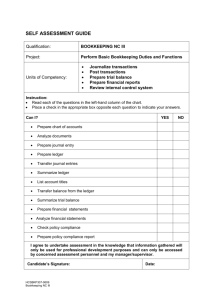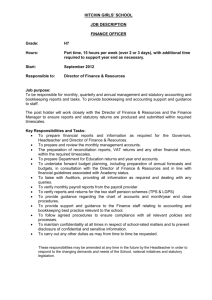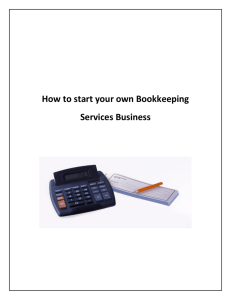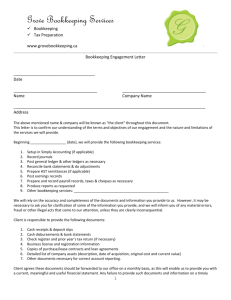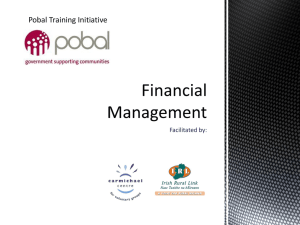Analyzing Bookkeeping Express Summary Bookkeeping Express is
advertisement
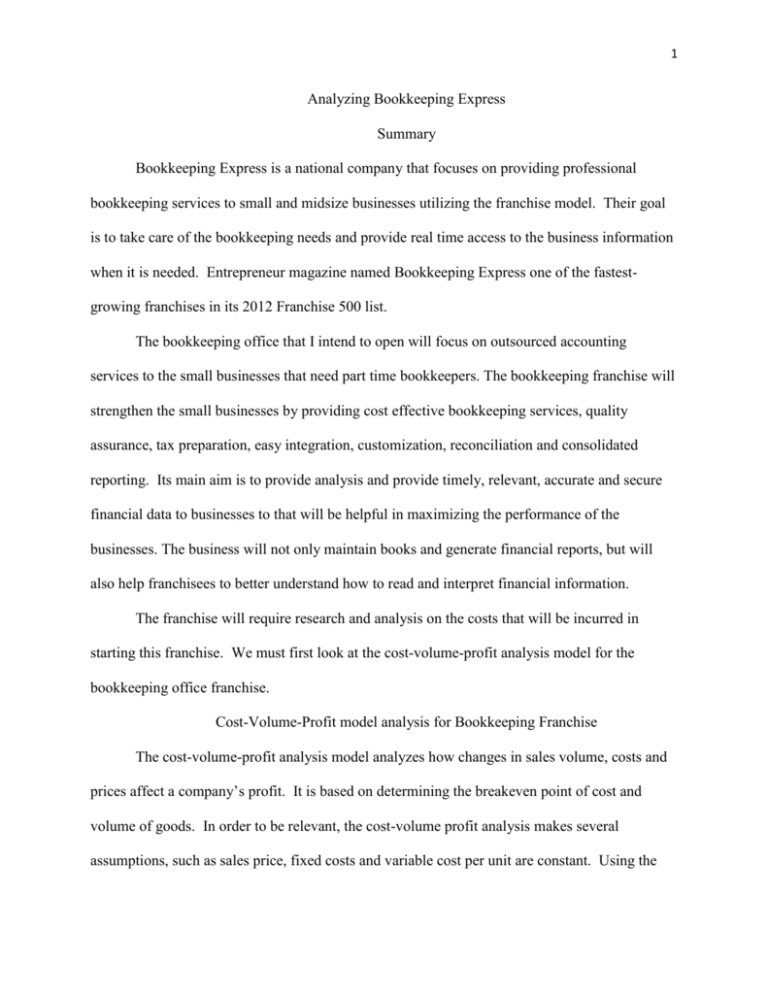
1 Analyzing Bookkeeping Express Summary Bookkeeping Express is a national company that focuses on providing professional bookkeeping services to small and midsize businesses utilizing the franchise model. Their goal is to take care of the bookkeeping needs and provide real time access to the business information when it is needed. Entrepreneur magazine named Bookkeeping Express one of the fastestgrowing franchises in its 2012 Franchise 500 list. The bookkeeping office that I intend to open will focus on outsourced accounting services to the small businesses that need part time bookkeepers. The bookkeeping franchise will strengthen the small businesses by providing cost effective bookkeeping services, quality assurance, tax preparation, easy integration, customization, reconciliation and consolidated reporting. Its main aim is to provide analysis and provide timely, relevant, accurate and secure financial data to businesses to that will be helpful in maximizing the performance of the businesses. The business will not only maintain books and generate financial reports, but will also help franchisees to better understand how to read and interpret financial information. The franchise will require research and analysis on the costs that will be incurred in starting this franchise. We must first look at the cost-volume-profit analysis model for the bookkeeping office franchise. Cost-Volume-Profit model analysis for Bookkeeping Franchise The cost-volume-profit analysis model analyzes how changes in sales volume, costs and prices affect a company’s profit. It is based on determining the breakeven point of cost and volume of goods. In order to be relevant, the cost-volume profit analysis makes several assumptions, such as sales price, fixed costs and variable cost per unit are constant. Using the 2 model allows us to estimate future costs, revenues and profits, which helps us monitor and plan operations. The analysis starts with the basic profit equation: Profit = Total revenue – Total costs Total Costs includes both fixed and variable cost, therefore, we can say that: Profit = Total revenue – Total variable costs – Total fixed costs We must next consider the contribution margin: Contribution Margin = Total revenue – Total variable costs Contribution Margin per unit = selling price per unit – variable cost per unit Selling price and Variable cost per unit are constant. Profit = (selling price * quantity)-(variable cost * quantity) – fixed cost We then rewrite the profit equation in terms of the contribution margin per unit. P = Selling price per unit V = Variable cost per unit F = Fixed cost Q = Quantity of product sold Profit = (Selling Price X Quantity) – (Variable Cost X Quantity) – Fixed Cost Profit = (P –V)Q - F Contribution Margin = Selling Price - Variable Cost Cost-Volume-Profit Analysis in Units Sales Net Profit Cost Variable Cost (Total SG&A) Fixed Cost Variable Cost Sales Profits 100% 57.64% (BizMiner, 2009) 42.36% 17.91% (BizMiner, 2009) $50,000 (Success in bookkeeping, 2012) $30,000 (BookKeeping Express) 30,000 / 17.91% = 167,504 57.64% X 167,504 = 96,549 3 Contribution Margin =$137,504 ($167,504 - $30,000) Profit = (P –V) Q-F $96,549 = 137,504 Q- 50,000 96,549 + 50,000 = 137,504 Q Q = 146,549/137,504 Q = 1.06577 units The quantity of sales needed for the target profit to be reached is 1.07 units Cost-Volume-Profit Analysis in Revenues Cost-Volume-Profit analysis in revenues: Contribution margin ratio = contribution margin per unit / selling price per unit Contribution margin ratio = (137,504/1.07)/ (167,504/1.07) Contribution margin ratio = 128,508 / 156,545 Contribution margin ratio = .8208 Contribution margin ratio of .8208 implies that 82.08% of the revenue from each unit sold contributes first to fixed costs then to the profits after fixed costs are covered. Breakeven point for Bookkeeping Service Breakeven point is the point where revenues cover all of the fixed and variable costs resulting in no profits. Sales per unit = 156,546 and fixed cost =50,000 and variable cost per unit 28,037 Break even quantity = (50,000 +0)/(156,546 - 28,037) = 50,000 /128,509 =.389 or .4units Cost Function Estimates Account Classification method, also known as account analysis, is a cost estimation method that examines accounts in the general ledger, allowing the accountant to use the information with their judgment to determine how cost will react in the future. 4 Y = a + bX Y = production cost X = number of units a = fixed costs b= variable cost per unit Since a= 50,000 and b= 28,037 Y = 50,000 + 28,037X The High-Low method is an accounting technique that uses the highest and lowest total cost as a basis for estimating the fixed and variable elements of a mixed cost. y = a + bx Y = total cost a = fixed cost b = variable cost per unit x = level of activity (which would be the high or low point) Since there are no high or low activity points, I have estimated totals and used the Quantity of 1.07 and the breakeven units of .4 units. Variable cost per unit = 80,000 – 61,214.80 / (1.07 -.4) Variable cost = 28,037.61 80,000 = 28,037.61 * 1.07 + b 50,000.41 = b Y = 28,037.61X + 50,000.41 The Regression analysis is a procedure used for estimating the relationship between the dependent variable and one or more independent variables. In estimating the cost volume formula, regression analysis tries to find a line of best fit. X Y 1.07 .4 80,000 61,214.80 80000 = 28,037.61*1.07 + b so Y intercept = 49,999.75 Beta = 28,037.61 Therefore, Y = 49,999.75 + 28,037.61X The cost estimates that I used are only partially valid due to the fact that the data that I used only covers a single period. The estimates would have been more accurate if there was more data available to use from multiple periods. I feel the cost estimation method that would be the most 5 beneficial would be the high low method as it reviews data from multiple points and can provide a statistical linear relation between the dependent and independent variables. Clients will be charged a fee of $40 per hour. 6 References Cost Volume Profit analysis. (2004). Chapter 3: cost volume Profit analysis. Retrieved from http//www.wiley.com/college/sc/eldenburg/ch03.pdf Cost-Volume Profit Analysis Definition/Investopedia. (N.d.). Retrieved from http://www.investopedia.com/terms/c/cost-volume-profit-analysis.asp BizMiner. (2010). Free Business Statistics and financial Ratios. Retrieved from http://www.bizstats.com/sole-proprietorship-business-financials/professional-scientifictechnical-services-12.0000/certified-public-accountants-12.0200/show Success in bookkeeping (2011). Bookkeeping Franchise. Retrieved from http://www.success-inbookkeeping.com/bookkeeping-franchise.html BookKeeping Express: What the small Business owner needs... (n.d.). Retrieved from http://www.franchiseknowhow.com/operations/bookkeepingexpress.htm BookKeeping Express | Linkedln. (n.d.). Retrieved from http://www.linkedin.com /company /bookkeeping-express Business Owner | BookKeeping Express. (n.d.). Retrieved from http://bookkeepingexpress.com services/business-owner/
